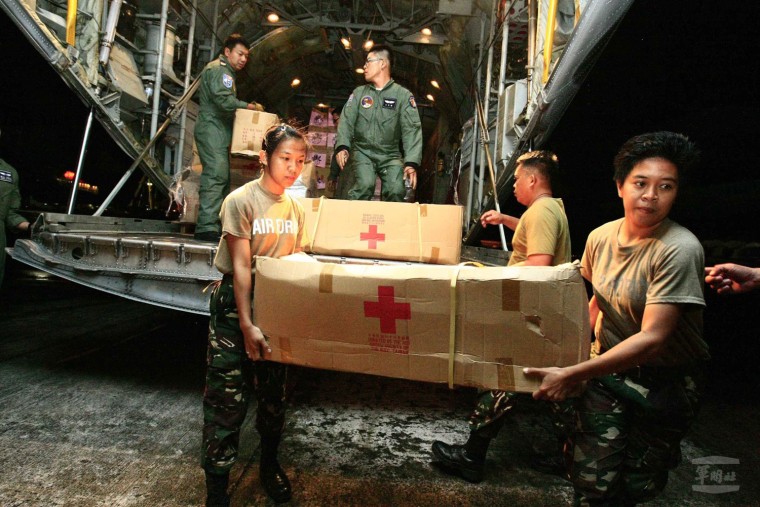
Seven days after the powerful Typhoon Haiyan slammed into the Philippines, aid was still slow to trickle in to desperate survivors due to a paralyzed infrastructure and widespread looting.
In the worst-hit city, Tacloban, Mayor Alfred Romualdez said authorities lacked the necessary manpower and vehicles to both deliver supplies and to clear bodies off the streets.
"It's scary," Romualdez told Reuters. "There is a request from a community to come and collect bodies, they say it's five or 10. When we get there, it's 40."
The mayor said the options are bleak in Tacloban: "The choice is to use the same truck either to distribute food or collect bodies."
Haiyan’s 195 mph winds and huge storm surges killed thousands, displaced nearly 600,000 and affected 9.5 million people across the Philippines, according to the United Nations. Nearly 4 million of those affected are thought to be children, according to international aid organization Save the Children.
Officially, confirmed deaths stood at 2,357 on Thursday morning, according to the Filipino government.
Damaged roads and airports were also hampering international efforts to help the thousands of residents in need of food, clean drinking water and medicine.
Meanwhile, aid continued to come in, with food and other goods stacking up at the airport in Tacloban. The U.S. military conducted approximately 40 flights, bringing in more than 400 relief workers, according to Brig. Gen. Paul Kennedy, the on-site commander of U.S. military relief efforts in the Philippines.
The military also airlifted more than 800 displaced people, but there are hardly enough flights for all the people wishing to leave the hardest-hit areas.
Many walked for hours to make it to the airport, where they wait in droves with little water or food.
When asked how she and her four children made it through three days of waiting in the hot sun and torrential downpours, Marivic Badilla, 41, held up a small battered umbrella. "We have been sheltering under this," she told Reuters, tears streaming down her face.
In the following 24 hours, U.S. Marines said they expected to receive about 180,000 pounds of USAID relief supplies, including plastic sheeting, hygiene kits, food and water.
The USS George Washington aircraft carrier was also due to arrive in the Philippines on Thursday evening, along with other ships.
The carrier has 5,000 sailors and more than 80 aircraft on board, officials said.
The troops are expected to boost relief efforts in areas where the destruction is so complete that aid workers walked for hours and didn't see a single standing building.
Making matters worse, police and soldiers are struggling to keep order across the region amid widespread looting and reports of armed gangs roaming the streets.
According to reports from aid workers on the ground, in some areas militias have blocked bridge access to request ransom payments from food truck convoys.
Philippine Energy Secretary Jericho Petilla said troops fired shots Wednesday at a group of armed men who approached a power transmission sub-station in Leyte province, The Associated Press reported. The men fired back at the troops then fled, he said, adding that nobody was hurt.
The precarious security also worries humanitarian workers.
“The Tacloban team is facing enormous constraints because we cannot move around freely due to the security situation,” said Elisabeth Byrs of the World Food Program, which is coordinating logistics for the aid and recovery effort.
Krista Armstrong of Save the Children, which is waiting for 100 tons of aid and four mobile health units to land in Cebu on Thursday morning, called on the government of the Philippines to help make sure humanitarian workers could do their jobs.
Desperation triggered anarchy in communities flattened by the typhoon, and police were working to keep order across the region.
Eight people were crushed to death as thousands of people stormed a rice warehouse in Alangalang and carted away up to 100,000 sacks of rice, National Food Authority spokesman Rex Estoperez told The Associated Press.
Soldiers sent to restore order also fired into the air to scatter crowds scavenging through the ruins in Tacloban, where an NBC News crew spotted dozens of uncollected bodies in the streets on Wednesday.
Standing amid the rubble, Jennica Ekaya told the BBC that survivors were only looking for food.
"We can survive without these houses ... we'll sleep anywhere. But we need food. Only food," she said. "No money, no places, no televisions, no cellphones, no technology. Food, we need food."
Medical charity Medecins Sans Frontieres (Doctors Without Borders) described a desperate situation in Guiuan, home to 45,000 people.
"People are living out in the open ... The needs are immense and there are a lot of surrounding villages that are not yet covered by any aid organizations," Alexis Moens, the organization's assessment team leader, said in a statement.
Petilla, the energy secretary, said Wednesday it may take six weeks before the first typhoon-hit towns get their electricity restored, according to the AP.
In Tacloban, he said, security issues needed to be addressed first "because if there's no peace and order, it's hard to reinstall the power posts."
NBC News' Alexander Smith, Christina Marker and The Associated Press and Reuters contributed to this report.
Related: